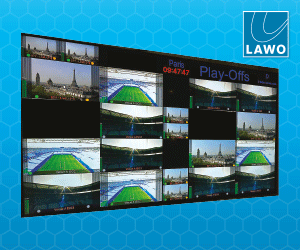With a growing footprint across the Middle East, Grass Valley is navigating the challenges and opportunities of a broadcast market in transition. In an exclusive interview with BroadcastPro ME, GV’s VP of Sales for EMEA, Mark Gardner, discusses how evolving needs in the Middle East are shaping the company’s regional strategy.
What kind of momentum are you seeing for Grass Valley across the Middle East?
We’re continuing to see strong growth in our traditional products such as cameras, switchers and IP solutions. However, what’s especially exciting is the growth in our software offerings. At last year’s CABSAT, we announced a new partnership with Arabsat to provide our cloud playout software, Playout X, as a managed service. This year Arabsat showcased it at their booth, and we’re thrilled to welcome new customers to the platform through this partnership.
We’re also seeing increasing interest in remote production for sports coverage. Technologies we’ve been successfully deploying in mainland Europe, particularly in the Netherlands and the UK, are now beginning to gain traction in the Middle East.
Can you share any customer use cases in the region?
We worked closely with NEP on their new IP trucks for the Middle East, supplying cameras and switchers, which were showcased at CABSAT. This collaboration also included our new shallow-depth-of-field camera, the LDX 180, a single large-sensor model that delivers a cinematic look for sports. Although the camera’s official release is scheduled for IBC, NEP provided a regional sneak preview. This highlights the strength of our partnership. What stands out is how this technology allows broadcasters to achieve cinematic storytelling without added operational complexity. NEP was able to connect the camera to their system just like any other, integrating it into their existing live workflow. The result is the ability to tell more creative stories while maintaining a streamlined and more efficient production process.
You’ve been discussing AMPP for some time. Has that translated into real-world applications?
It’s more than a POC now. For example, AMPP is being used across all Saudi Pro League games. They are using it for ingest and then using FrameLight X, our production asset management system, for highlight cuts. This relationship continues to grow, and we are helping them explore additional ways to use AMPP, particularly in cloud and remote production workflows.
Given the breadth of your portfolio, where are you seeing the most traction?
Last year we saw significant growth in cameras and switchers, but one of our key areas of focus is software products. Playout for example is an area where we see strong potential in the region. We’re currently working with several customers on tests and proof-of-concept projects for both on-premises and cloud deployments. One of the strengths of our product line is its flexibility. You can deploy on-premises using COTS servers or in cloud environments such as AWS, Google Cloud, Oracle Cloud, Alibaba or whichever platform best suits your business needs.
What overarching message did you bring to CABSAT this year?
It’s the Grass Valley Media Universe, bringing all of our existing hardware products into the AMPP ecosystem. It’s a true platform approach, with the entire product range connected. We’re also making sure customers understand that it’s an open ecosystem. Third-party vendors are encouraged to join the system and benefit from the platform approach. In addition, we’ve been working on the Media Exchange Layer (MXL). This is an EBU initiative, and Grass Valley has been a strong supporter. It enables the exchange of video and audio flows on a CPU-based platform. We expect to make the SDK available to customers in the coming months, giving them confidence that the platforms will remain open and that interoperability is built in.
What are the biggest challenges right now from a sales standpoint?
The breadth of our portfolio is always a challenge. We’re selling software products, solutions that can be deployed on-premises or in cloud environments, and more traditional hardware products. We offer a lot of choice to customers, and while they benefit from that flexibility, they also want a clear understanding of where things are headed.
Cloud may be ideal for one customer, while another may benefit more from an on-premises deployment. For example, we spoke with a few customers in Saudi Arabia who feel that connectivity charges are still too high, making cloud less viable for them at the moment. In other parts of the region, however, customers may see the benefits of cloud and be ready to adopt it. We’re working to tailor our message to each individual market. It’s a mistake to treat the Gulf as a single homogenous market. Each country is unique, with its own specific needs and conditions.
Where will Grass Valley focus its efforts next?
Interoperability remains a top priority for us. We are actively involved in initiatives like the Media Exchange Layer (MXL) and are accelerating our efforts in this area. Our goal is to ensure that customers can seamlessly integrate our solutions with other software environments. We understand that customers make long-term investments and need confidence that their systems will stay flexible and future-proof. By supporting open standards and speeding up development in areas like MXL, we are helping customers achieve the security and adaptability they need.
















































































